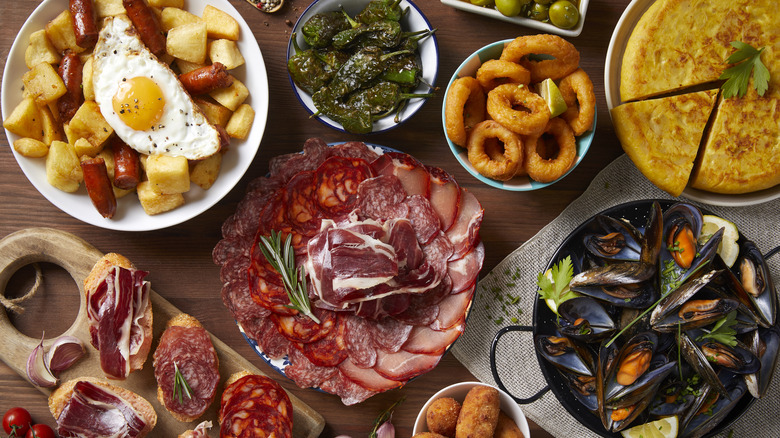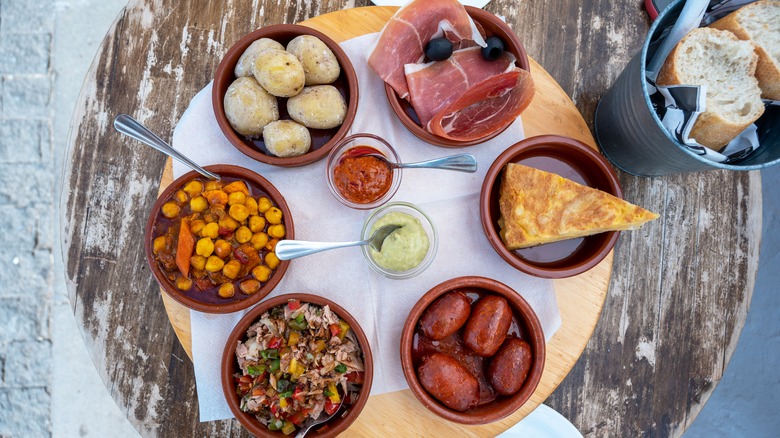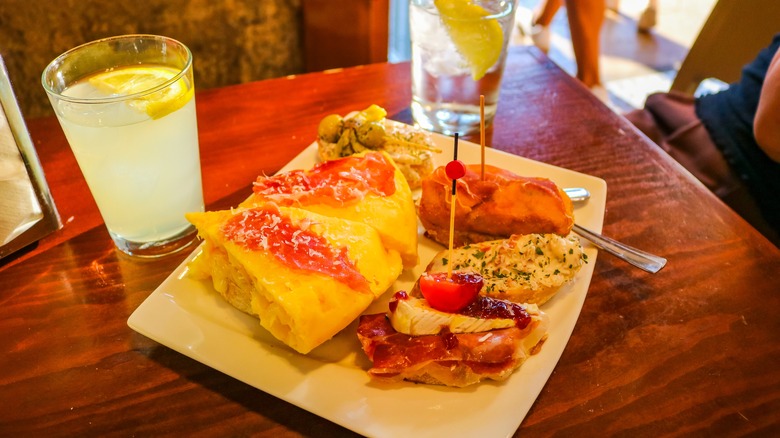What's The Difference Between Tapas And Pintxos?
Bar snacks come in all shapes and sizes. In America alone, we're spoilt for choice, with everything from nuts and popcorn to mozzarella sticks, chicken wings, and French fries. But if we venture beyond our borders, we'll find an even bigger selection of tidbits made with a variety of ingredients; Mexicans like their aguachile — a concoction of raw shrimp, lime juice, chile, cucumber, and onion. The French would hardly say "non" to moules mariniére or "sailor-style mussels" served with chunks of crisp French bread. In Thailand, there are few dishes that bring as much joy as pork skewers, or Moo Ping, per Serious Eats, while in Spain, it is custom to have a range of small bites known as tapas with their pre-dinner drinks.
But as Devour Tours points out, because of the size and diversity of Spain's gastronomic scene, locals from the different regions are likely to consume and enjoy bar snacks in a variety of ways, which explains the existence of pintxos, hailing from the Basque Country between Spain and France. And while both are small bites best enjoyed with wine or drinks, the difference between a tapa and a pintxo is more than semantic.
Tapas are a Spanish staple
Where tapas came from depends on who you ask. Some, like Spanish Hams, credit the southern Spanish province of Andalucia for first coming up with the concept, although it is also said King Alfonso X or "The Wise" decreed no wine could be served without a snack because he once was so ill he could only take small bites with wine. Take Two Tapas says early tapas were edible, savory coverings for wine glasses which had a tendency to attract flies since it was full of sweet sherry.
There may be a wide range of tapas choices that include olives, cheese, slices of ham, patatas bravas, and pulpo Gallego, but tapas can be categorized in several ways. One involves the way it is served, and per Take Two Tapas, these are cocas de picar which refers to small finger foods that can be nibbled on, cazuelas or bite-sized portions of dishes that are served up in a sauce, and pinchos, which require the assistance of a toothpick, a cocktail fork, or a skewer. Tapas can also be classified as hot or cold dishes; tostas or open-faced sandwiches served with toasted bread; and conservas or tapas made with canned ingredients like tuna or sardines, per Socarrat.
And while it might be tempting to consider the pintxo or "pincho" as a type of tapas, as some sites like Travel for Food point out, tapas are merely smaller servings of regular dishes, and pintxos are different.
Pintxos come from Basque Country
Per San Sebastian Pintxo Bars, pintxos or pinchos started off as finger foods that could be polished off after one or two bites. The name "pintxo" is actually Basque for "pinchar," which is Spanish for poke, or stab, per Eusko Guide. The sticks are considered important because, as sites like Food n Road point out, they are an indication of how much you have consumed — and how much your bill will come out to be.
Pintxos were originally served as slabs of crusty French bread or baguette on which toppings were placed and then held together with a toothpick or cocktail skewer. The first pintxo was said to have been invented in 1946 named Gilda (after a Hollywood character played by Rita Hayworth), and it was a combination of olive, pepper, and anchovy held together with a skewer, per San Sebastian Pintxo Bars.
Pintxo culture has moved beyond that today and can be made with bacalao, veal cheek, foie gras, squid, and pig trotters, per Culture Trip. Many pintxos aren't even served on slices of bread anymore. But no matter how the bar snack is served in The Basque Country, Devour Tours says pintxos are always served with a sparkling white known as txakoli, which is native to the region.


